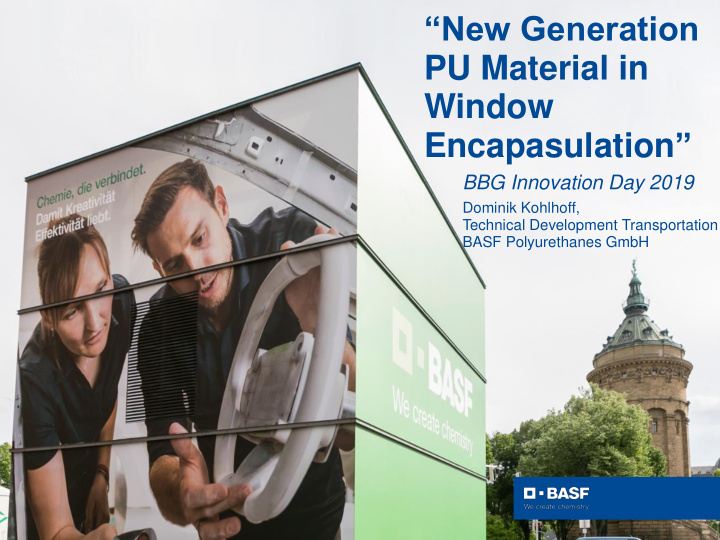



“New Generation PU Material in Window Encapasulation ” BBG Innovation Day 2019 Dominik Kohlhoff, Technical Development Transportation BASF Polyurethanes GmbH
Outline of Presentation Short Introduction Kinetics of PU- Reaction Material Properties Material Approval of OEMs Improved Testing of Material Conclusion 2 03.06.2019
Short Introduction History: • The actual aromatic systems have been developed already mid 90’s ELASTOLIT R8919/101/OA48 ELASTOLIT R8919/100/WE35 ELASTOLIT R8919/102/WE45 Challenge: • At that moment, they were fully fulfilling the requirements, as most • Development of systems having improved flowability for bigger molds, sunroofs had a limited weight of PU global recipes , lower emissions , being REACH conform , • More recently, more and more large parts (in weight of PU) are and keeping machine parameters at customers` constant coming into production This requires longer shot times. Thus, improved flowability/ kinetics required 3 03.06.2019
Kinetics of PU- Reaction • Tests were conducted using ViskoPakt by HiTec Zang GmbH 4 03.06.2019
Kinetics of PU- Reaction • Flowability of serial material is limited by increasing viscosity even before hardening of material • Early increase of viscosity makes higher shot weights and filling of complex molds difficult Determined under laboratory conditions 5 03.06.2019
Kinetics of PU- Reaction Completely new formulation with novel raw materials led to delayed reaction onset → viscosity is kept low and flowability could be improved Determined under laboratory conditions 6 03.06.2019
Kinetics of PU- Reaction ELASTOLIT R 8919/101/OA48 ELASTOLIT R 8919/107 ELASTOLIT R 8919/100/WE35 ELASTOLIT R 8919/108 ELASTOLIT R 8919/102/WE45 ELASTOLIT R 8919/109 7 03.06.2019
Material Properties Property Test unit Serial New method Material Generation Moulded ISO 1183-1 Kg/m³ 1060 1060 density Shore A ISO 7619-1 - 87 88 Tensile DIN 53504 MPa 12 13 strength Elongation DIN 53504 % 215 200 Tensile DIN 53504 MPa 28 26 modulus Tear ISO 34-1,B N/mm 28 27 resistance (b) shrinkage - % 1,25 1,2 8 03.06.2019
Material Properties Property unit Serial Material New Generation Peel test 7 N/cm 88 90 days Peel test N/cm 81 80 after cataplasm ageing 9 03.06.2019
Material Properties Serial Material VOC 200 ppm (averaged values): FOG 830 ppm Nonylphenol is detected New Generation VOC 120 ppm (averaged values): FOG 370 ppm no Nonylphenol → lower emissions and absence of Nonylphenol are nowadays OEM requirements for new encapsulation projects 10 03.06.2019
Material Properties Watercontent after absorption in Water (2°C) for Serial Material (dark grey) and New Generation (light grey) 4,5 4 Watercontent in wt% 3,5 3 2,5 2 1,5 1 0,5 0 72 144 96 120 Absorption [h] in Water at 2 °C 11 03.06.2019 | Optionale Zusatzinformationen
Material Approval of OEMs → Further OEMs made specific project approvals, evaluate material, or purchase aliphatic material 12 03.06.2019
Improved Testing of Material • Automatized QM apparatus for outgoing PU material needed • Requirement: automatized in-situ stirring and kinetic testing • Manual testing of start and rise time is conducted • Precise results for one operator • Reproducibility for more operators is lower than in case of automatized testing 13 03.06.2019
Improved Testing of Material • Torque meter for kinetic testing already built up at BASF`s Lemförde site • Implementation will be done in 2 nd half of 2019 14 03.06.2019
Conclusion New Generation PU Material → global PU systems with improved flowability, reduced emissions, and REACH conformity were successfully developed → OEMs with interest in aromatic material already approved New Generation material → BASF supports customers in questions of material approval at OEMs` Improved QC Material Testing → Novel testing method for quality control was developed → Implementation as criterion for outgoing inspection is ongoing → BASF supports customers in questions of material testing 15 03.06.2019 | Optionale Zusatzinformationen
Thank you for your attention! 16 03.06.2019
Recommend
More recommend